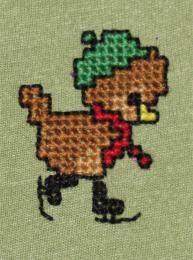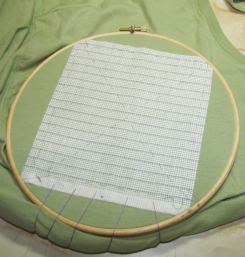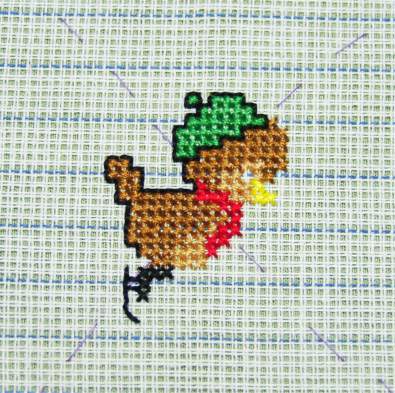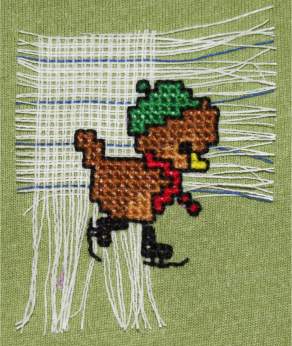- Home
- Using waste canvas
How to Use Waste Canvas
What is waste canvas for cross stitch?
If you've ever dabbled in cross stitch, you might have come across the term waste canvas.
No, it's not some rejected piece of material that stitchers toss aside. Quite the contrary!
Cross stitch is a counted thread technique which appears to rule out using it directly on your clothes. Waste Canvas offers an easy solution. It involves using a temporary layer that is then removed carefully, leaving your finished stitching exactly where you wanted it.
This one-use grid provides holes you can stitch just as if you were using Aida. This ensures your stitches are evenly placed and remain that way once the canvas is removed. One caveat is to make sure you don't pull your stitches too tight, otherwise the removal process becomes tricky.
Quick pick: Which option for your project?
Summary: Use waste canvas for sturdy fabrics and large areas; choose soluble canvas for delicate, or highly-detailed work.
Quick pick:
- T-shirts: 14 count waste canvas (default for most projects).
- Denim/heavy fabrics: 10 / 12 count
- Very coarse fabrics or large bold designs - 7 / 8.5 count.
- Delicate fabrics: Soluble stabiliser or 14-count waste canvas.
Key differences in removal method:
- Waste canvas: = pull threads
- Soluble canvas: = dissolves in water.
Testing tip: If unsure, test on a scrap of the same fabric.

Decorating clothes with needlework, like embroidery or cross stitch, is a trend that's gaining popularity, and the best part? It's incredibly easy to do!
Why not start with my free patterns and see where your creativity takes you?
The canvas comes in a number of different sizes, including 8.5, 11 and 14 threads per inch.
Before we dive into the fun part – stitching – let's take a few minutes to prepare our canvas.
What you'll need
- The garment you wish to stitch on and your pattern
- Embroidery hoop
- Waste canvas (8.5, 11 or 14 hpi)
- A needle (ballpoint for knits or t-shirts, sharp for other fabrics)
- Embroidery floss or thread
- Tweezers and a water sprayer (for removing the waste canvas)
Prepare for using waste canvas
- Cut the waste canvas according to the design size, allowing 2-3 inches (5-7.5 cm) allowance.
- Fold your canvas in half both ways to find the centre. Mark with a pencil.
- Align the centre of the canvas with where you want the design to sit on your garment.
- Use pins or fabric clips to hold the canvas in place, lining up the grid lines with the fabric weave if possible.
- Baste using long stitches and a contrasting colour of sewing thread (not floss) around the edge of the waste canvas to ensure it doesn't move.
- Remove pins then hoop your garment and waste canvas "sandwich" to keep the fabric smooth without stretching it out of shape. Don't overtighten the screw on the hoop.
Managing Excess Fabric

If your garment has excess fabric beyond the stitching area, like the tee-shirt in my demonstration, don't worry!
Simply roll the extra fabric at the bottom and secure it with large tacking stitches to the canvas's selvedge.
Do the same for any fabric at the top.
This keeps everything tidy and out of the way while you do the stitching.
Cross Stitching on waste canvas

- Choose the best needle - blunt for knits, sharp for more firmly woven fabrics.
- Start stitching from the centre of your waste canvas and pattern, to ensure the design will fit properly. This may not be the centre of your garment.
- Note that your waste canvas is formed with a double thread. Stitch through the larger holes formed by these double threads, not the tiny holes between them. This makes removal of the canvas later, easier.
- Keep your tension snug but not tight, make sure all top stitches lay in the same direction and don't carry the thread too far across the back of the work. When fastening off, don't take the needle through the threads of the canvas, as this will make removal difficult.
How to remove waste canvas
- Remove your basting stitches.
- Spritz small pieces of work, or soak larger items for a few minutes using cold water. If you used soluble canvas soaking will be the only step needed.
- Once the canvas has softened slightly, use your tweezers to coax each thread out gently. Don't yank or pull suddenly.
- If a thread doesn't pull out easily try snipping it in the middle, carefully avoiding your cross stitches. Then work from both ends.
- Solidly stitched areas may need further care and use of a magnifying lens. Work slowly and remove any trapped canvas, snipping where necessary.
- Rinse the finished item to remove starchy residue and release any errant canvas that you may have missed.
- Lay the garment on a towel and roll to remove any excess water.
- Air-dry then press lightly from the reverse over a soft towel to cushion your cross stitch.

Frequently Asked Questions
In which direction should I place the Blue Line on the waste fabric? ... from Phyllis in Georgia
In which direction should I place the Blue Line on the waste fabric? ... from Phyllis in Georgia
Answer from Valerie Kalyani
Phyllis, the blue line is only to help you to count. The direction you put it does mean a thing, the waste canvas is 14 in both directions. It is just a matter of your choice in using this counting aid.
Also, did you know you can use waste canvas over one? As long as you consistently put your needle through the very center of each square, you will get an even 28 count with your 14 waste canvas.
Stay connected between projects
If you’d like occasional updates from my embroidery room, including new patterns, gentle tips, and little things I think you might enjoy, you’re warmly invited to join the Stitchin’ Times newsletter.
No pressure. Just a friendly note now and then to keep you inspired.


